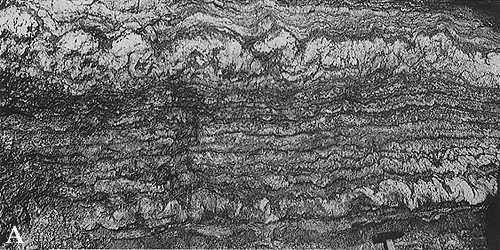

Enterolithic folds
Plate 127
The contorted and tightly folded layers of these pictures are composed of white, saccharoidal gypsum (calcium sulfate); we first met this variety of gypsum (alabastrino ) in the evaporiti c-anoxic deposits seen in plate 49. There, the beds were plane-parallel or only slightly undulated. Here, instead, they are deformed. The origin of this type of deformation has been hotly debated, and more than one explanation is possible, as was pointed out in the case of convolute lamination (plate 116).
When evaporitic environments were poorly known, alabastrino gypsum was thought to derive from the swelling of a previous sulfate, anhydrite, through hydration and recrystallization. Gypsum is a hydrated mineral, in fact, whereas anhydrite, as the name indicates, is anhydrous. Incorporation of water molecules in the crystal lattice implies an increase in volume. The secondary origin of alabastrino proved right but not the expansion theory. If the original aggregate of anhydrite crystals forms an open mush, when they are hydrated into gypsum the expansion can be absorbed by the pores and does not cause a swelling of the aggregate.
When inland and coastal sabkhas were explored (these are sedimentary environments barren of vegetation and encrusted by salts in arid areas), anhydrite aggregates were found just below the topographic surface, in the form of nodules (see plates 172-174), and laterally coalesced nodules forming bands, laminae or beds, often with enterolithic folds (A). Nodules with the same color and shape occur in the fossil record, but are made of secondary gypsum (or, sometimes, other minerals, like quartz). This makes clear that replacement of anhydrite by gypsum does not change the volume and the shape of nodules. The observed deformations, therefore, cannot be attributed to hydration and swelling; they are, instead, produced by the growth mechanism of nodules.
Anhydrite nodules grow in a host sediment but do not accept impurities inside (whence their bright white color); therefore, continued growth displaces and compresses the embedding sediment. If the expanding nodules are confined both vertically (by the weight of overlying sediments) and laterally, the only outlet left to them is lateral compression and folding.
This actualistic approach to nodular and enterolithic structures in evaporites explains very well the case of plate 128 A, where the gypsum is host in red continental deposits of Permian age (Bellerophon Formation of southern Alps). Its validity is more dubious when the structures are preferentially located around faults and zones of tectonic deformation (B, Messinian "serpentino" from a Sicilian mine or "solfara"); moreover, the gypsum is embedded in dark, bituminous marine marls like those shown in plate 49. These findings suggest the possibility that plastic gypsum mush or sulfate-rich solutions are injected under pressure by tectonic stresses, which could also cause tight folding (see plate 178).